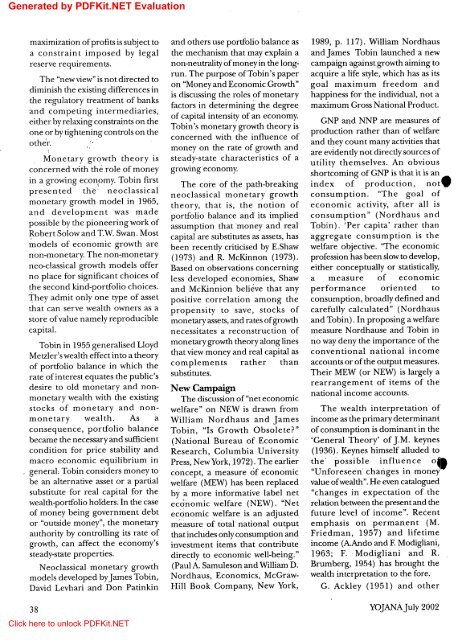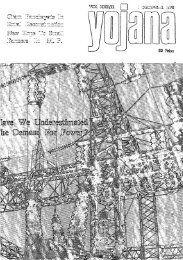Banking - Yojana
Banking - Yojana
Banking - Yojana
- TAGS
- banking
- yojana
- yojana.gov.in
You also want an ePaper? Increase the reach of your titles
YUMPU automatically turns print PDFs into web optimized ePapers that Google loves.
Generated by PDFKit.NET Evaluation<br />
maximization of profits issubject to<br />
a constraint imposed by legal<br />
reserve requirements.<br />
The "newview"isnot directed to<br />
diminish the existing differences in<br />
the regulatory treatment of banks<br />
and competing intermediaries,<br />
either byrelaxing constraints on the<br />
one or bytightening controls on the<br />
othe'r.<br />
Monetary growth theory is<br />
concerned with the role of money<br />
in a growing econpmy. Tobin first<br />
presented the: neoclassical<br />
monetary growth model in 1965,<br />
and development was made<br />
possible by the pioneering work of<br />
Robert Solow and T.W.Swan. Most<br />
models of economic growth are<br />
non-monetary. The non~monetary<br />
neo-classical growth models offer<br />
no place for significant choices of<br />
the second kind-portfolio choices.<br />
They admit only one type of asset<br />
that can serve wealth owners as a<br />
store of value namely reproducible<br />
capital.<br />
Tobin in 1955 generalised Lloyd<br />
Metzler's wealth effect into a theory<br />
of portfolio balance in which the<br />
rate of interest equates the public's<br />
desire to old monetary and nonmonetary<br />
wealth with the existing<br />
stocks of monetary and nonmonetary<br />
wealth. As a<br />
consequence, portfolio balance<br />
became the necessary and sufficient<br />
condition for price stability and<br />
macro economic equilibrium in<br />
general. Tobin considers money to<br />
be an alternative asset or a partial<br />
substitute for real capital for the<br />
wealth-portfolio holders. In the case<br />
of money being government debt<br />
or "outside money", the monetary<br />
authority by controlling its rate of<br />
growth, can affect the economy's<br />
steady-state properties.<br />
Neoclassical monetary growth<br />
models developed byJames Tobin,<br />
David Levhari and Don Patinkin<br />
38<br />
Click here to unlock PDFKit.NET<br />
and others use portfolio balance as<br />
the mechanism that may explain a<br />
non-neutrality of money in the longrun.<br />
The purpose of Tobin's paper<br />
on "Moneyand Economic Growth"<br />
is discussing the roles of monetary<br />
factors in determining the degree<br />
of capital intensity of an economy.<br />
Tobin's monetary growth theory is<br />
concerned with the influence of<br />
money on the rate of growth and<br />
steady-state characteristics of a<br />
growing economy.<br />
The core of the path-breaking<br />
neoclassical monetary growth<br />
theory, that is, the notion of<br />
portfolio balance and its implied<br />
assumption that'money and real<br />
capital are substitutes as assets, has<br />
been recently criticised by E.shaw<br />
(1973) and R. McKinnon (1973).<br />
Based on observations concerning<br />
less developed economies, Shaw<br />
and McKinnion believe that any<br />
positive correlation among the<br />
propensity to save, stocks of<br />
monetary assets,and rates of growth<br />
necessitates a reconstruction of<br />
monetary growth theory along lines<br />
that viewmoney and real capital as<br />
complements rather than<br />
substitutes.<br />
New Campaign<br />
The discussion of "net economic<br />
welfare" on NEW is drawn from<br />
William Nordhaus and James<br />
Tobin, "Is Growth Obsolete?"<br />
(National Bureau of Economic<br />
Research, Columbia University<br />
Press, NewYork,1972). The earlier<br />
concept, a measure of economic<br />
welfare (MEW) has been replaced<br />
by a more informative label net<br />
ecdnomic welfare (NEW). "Net<br />
ecdnomic welfare is an adjusted<br />
m~asure of total national output<br />
that includes onlyconsumption and<br />
investment items that contribute<br />
directly to economic well-being."<br />
(Paul A. Samuleson and William D.<br />
Nordhaus, Economics, McGraw-<br />
Hill Book Company, New York,<br />
1989, p. 117). William Nordhaus<br />
and James Tobin launched a new<br />
campaign againstgrowth aiming to<br />
acquire a life style, which has as its<br />
goal maximum freedom and<br />
happiness forthe individual, not a<br />
maximum Gross National Product.<br />
GNP and NNP are measures of<br />
production rather than of welfare<br />
and they count many activities that<br />
are evidently not directly sources of<br />
utility themselves. An obvious<br />
shortcoming of GNP is that it is an<br />
index of production, note<br />
consumption. "The goal of<br />
economic activity, after all is<br />
consumption" (Nordhaus and<br />
Tobin). 'Per capita' rather than<br />
aggregate consumption is the<br />
welfare objective. "The economic<br />
profession has been slowto develop,<br />
either conceptually or statistically,<br />
a measure of economic<br />
performance orien ted to<br />
consumption, broadly defined and<br />
carefully calculated" (Nordhaus<br />
and Tobin). In proposing a welfare<br />
measure Nordhause and Tobin in<br />
no waydeny the importance of the<br />
conventional national income<br />
accoun tsor of the output measures.<br />
Their MEW (or NEW) is largely a<br />
rearrangement of items of the<br />
national income accounts.<br />
The wealth interpretation of<br />
income as the primary determinant<br />
of consumption is dominant in the<br />
'General Theory' of J.M. keynes<br />
(1936). Keynes himself alluded to<br />
the' possible influence o'<br />
"Unforeseen' changes in money<br />
valueofwealth".He even catalogued<br />
"changes in expectation of the<br />
relation between the present and the<br />
future level of income". Recent<br />
emphasis on permanent (M.<br />
Friedman, 1957) and lifetime<br />
income (A.Ando and F.Modigliani,<br />
1963; F. Modigliani and R.<br />
Brumberg, 1954) has brought the<br />
wealth interpretation to the fore.<br />
G. Ackley (1951) and other<br />
YOJANAJuly2002






